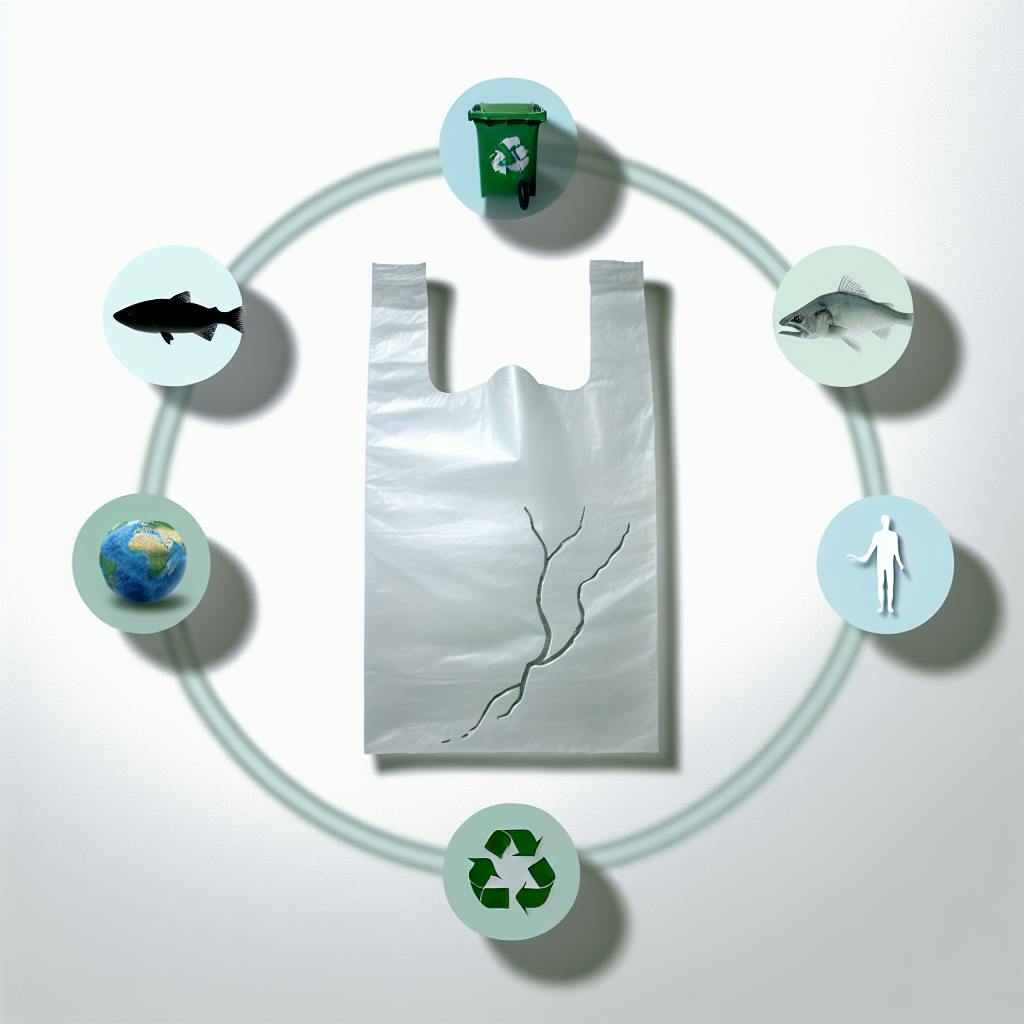Microplastics are tiny plastic particles that don't break down easily and are found everywhere in the environment. Studies show that microplastics in soil lead to higher emissions of greenhouse gases like methane, carbon dioxide, and nitrous oxide, contributing to global warming and climate change.
Related video from YouTube
Key Points
- Microplastics disrupt soil microbes and processes involved in carbon and nitrogen cycles, altering greenhouse gas production.
- More and larger microplastics in soil generally mean higher greenhouse gas emissions.
- The impact depends on factors like microplastic type, size, and amount, as well as soil properties and environmental conditions.
| Microplastic Type | Greenhouse Gas Impact |
|---|---|
| Polyethylene (PE) | Causes the biggest rise in methane (CH4) emissions |
| Polypropylene (PP), Polyvinyl Chloride (PVC), Polystyrene (PS), Polyester (PET) | Boost emissions of nitrous oxide (N2O), carbon dioxide (CO2), and CH4 |
| Phenol-Formaldehyde | Major increase in N2O emissions, higher global warming impact |
| Polylactic Acid (PLA) | Higher CO2 emissions, but relatively low global warming impact |
Why Act Now?
- Microplastics building up in soils threaten soil health and food production in the long run.
- Increased greenhouse gas emissions worsen climate change and its environmental and economic impacts.
- Microplastics can spread widely, making this a global issue needing international cooperation.
What Can Be Done?
- Policymakers: Introduce rules to limit microplastic pollution, promote sustainable practices, and encourage alternatives to plastics.
- Researchers: Focus on interdisciplinary studies to fill knowledge gaps, develop monitoring and remediation techniques, and explore sustainable alternatives to microplastic products.
- Industries: Invest in biodegradable and eco-friendly alternatives to plastics, especially in agriculture. Adopt responsible waste management.
- Farmers and Agricultural Communities: Use sustainable farming methods with minimal plastic, and properly dispose of and recycle agricultural plastics.
- Consumers: Reduce plastic use, support sustainable companies and initiatives, and participate in community efforts against microplastic pollution.
- International Organizations: Facilitate global cooperation, knowledge-sharing, and coordinated efforts to address microplastic pollution and its environmental impacts, including greenhouse gas emissions.
The Problem: Microplastics and Greenhouse Gases
How Microplastics Get into Soil
Microplastics can enter and build up in soil through various ways:
- Farming Practices: Using plastic mulch films and improper disposal of farm plastics leads to microplastic pollution in farmlands.
- Sewage Sludge: Wastewater treatment plants remove microplastics, which end up in sewage sludge used as fertilizer on fields.
- Air Deposition: Microplastics can travel through the air and settle on soil surfaces.
- Larger Plastic Breakdown: Bigger plastic debris breaks down into smaller microplastic particles over time due to weathering and degradation.
Studies have found high levels of microplastics in agricultural soils, ranging from tens to thousands of particles per kilogram of soil, depending on the location and sources of contamination.
Effects on Soil Microbes
Microplastics can significantly impact soil microbial communities, changing their diversity, abundance, and activity:
- Microbial Diversity: Soils with microplastics often have lower microbial diversity compared to uncontaminated soils, with distinct microbial communities forming on the microplastic surfaces (plastisphere).
- Microbial Activity: Microplastics can influence microbial metabolic activities, such as nitrogen fixation, nitrification, and denitrification, which are directly linked to greenhouse gas emissions.
- Greenhouse Gas Production: Changes in microbial communities and activities can lead to increased emissions of carbon dioxide (CO2), methane (CH4), and nitrous oxide (N2O) from soils.
Impacts on Soil Carbon Cycle
Microplastics can disrupt the soil carbon cycle, affecting carbon storage and turnover:
| Impact | Description |
|---|---|
| Carbon Sequestration | Microplastics can interfere with the decomposition of organic matter, reducing the formation of stable soil carbon pools and potentially decreasing carbon sequestration. |
| Soil Respiration | Alterations in microbial communities and activities can influence soil respiration rates, leading to increased CO2 emissions from soils. |
| Priming Effects | Microplastics can stimulate the decomposition of native soil organic matter, releasing additional CO2 into the atmosphere. |
Other Processes Affected
Microplastics can influence various other processes in soils, contributing to greenhouse gas emissions:
- Nutrient Cycling: Microplastics can affect the cycling of essential nutrients like nitrogen and phosphorus, impacting microbial processes involved in greenhouse gas production.
- Soil Structure and Water Dynamics: Changes in soil physical properties due to microplastics can alter water retention, aeration, and microbial habitats, indirectly influencing greenhouse gas emissions.
- Contaminant Interactions: Microplastics can absorb and transport other contaminants, potentially affecting microbial communities and their greenhouse gas-producing activities.
sbb-itb-1dc3f59
Factors Influencing Microplastics and Greenhouse Gases
Microplastic Properties
The type, size, and amount of microplastics in soil play a big role in how much they increase greenhouse gas emissions:
- Polyethylene (PE): Studies show that as PE microplastics increase in soil, they cause the biggest rise in methane (CH4) emissions.
- Polypropylene (PP), Polyvinyl Chloride (PVC), Polystyrene (PS), and Polyester (PET): These microplastics have been found to boost emissions of nitrous oxide (N2O), carbon dioxide (CO2), and CH4 in farmland soils.
- Phenol-Formaldehyde: This type leads to a major increase in N2O emissions, resulting in a higher global warming impact.
- Polylactic Acid (PLA): PLA microplastics are linked to higher CO2 emissions, but their overall global warming impact is relatively low.
Larger microplastic particles tend to increase greenhouse gas emissions more than smaller ones. Higher concentrations of microplastics in soil generally mean higher emissions.
Soil Characteristics
The properties of the soil can change how much microplastics affect greenhouse gas emissions:
| Soil Property | Effect |
|---|---|
| Texture | Clay soils tend to have higher CO2 emissions with microplastics compared to sandy soils. |
| Organic Matter Content | Soils with more organic matter may see increased CO2 emissions due to microplastics stimulating the breakdown of organic matter. |
| pH | Neutral soils (pH around 7) have higher CO2 and N2O emissions with microplastic contamination compared to acidic or alkaline soils. |
| Water Content | Saturated or very moist soils can promote higher CO2 emissions in the presence of microplastics. |
Environmental Conditions
Environmental factors like temperature and moisture can influence how microplastics affect greenhouse gas emissions in soil:
1. Temperature
Higher temperatures generally increase microbial activity and the rate of microplastic breakdown, potentially leading to higher greenhouse gas emissions.
2. Moisture
Adequate soil moisture levels are needed for microbial activity and microplastic breakdown, which can affect greenhouse gas production.
3. Seasonal Variations
The effects of microplastics on greenhouse gas emissions may vary by season due to changes in temperature, rainfall, and soil conditions.
Potential Solutions
Reducing Microplastic Sources
One key way to lower the impact of microplastics on greenhouse gas emissions is to cut down on their introduction into the environment. This can be done through:
-
Better Waste Management: Improving waste collection, recycling, and disposal practices can prevent microplastics from entering soil and water systems.
-
Regulations on Plastic Use: Governments can introduce policies and rules to limit the production and use of single-use plastics, encourage the development of biodegradable alternatives, and promote sustainable practices in industries that contribute to microplastic pollution.
-
Public Awareness and Education: Raising awareness about the environmental impacts of microplastics and promoting responsible consumption and disposal habits can significantly reduce microplastic pollution.
Using Living Organisms to Break Down Microplastics
Techniques that involve using living organisms to break down or remove pollutants can be effective in mitigating the impact of microplastics in soil:
-
Microbial Breakdown: Certain microorganisms, such as bacteria and fungi, can degrade and break down microplastics. Introducing these microbes into contaminated soil or enhancing their activity through the addition of nutrients or enzymes can help break down microplastics and reduce their impact on greenhouse gas emissions.
-
Plant Absorption: Some plants can absorb and accumulate microplastics from soil. By carefully selecting and cultivating these plants, microplastics can be removed from the soil, reducing their impact on greenhouse gas emissions.
Soil Amendments and Treatments
Adding materials or applying treatments to soil can help mitigate the negative effects of microplastics on greenhouse gas emissions:
| Amendment/Treatment | Description |
|---|---|
| Biochar | Adding biochar, a carbon-rich material produced from the pyrolysis of biomass, to soil has been shown to reduce the impact of microplastics on greenhouse gas emissions. Biochar can adsorb microplastics and modify soil properties, potentially reducing their effects on microbial communities and greenhouse gas production. |
| Compost and Organic Amendments | Incorporating compost or other organic amendments into soil can improve soil structure, increase microbial activity, and potentially reduce the negative impacts of microplastics on greenhouse gas emissions. |
| Soil Treatments | Applying soil treatments, such as pH adjustments or the addition of specific minerals or nutrients, may help mitigate the effects of microplastics on soil microbial communities and greenhouse gas emissions. |
Monitoring and Research Needs
To effectively address the issue of microplastics in soil and their impact on greenhouse gas emissions, ongoing monitoring and research efforts are crucial:
-
Standardized Detection and Quantification Methods: Developing standardized methods for detecting and quantifying microplastics in soil is essential for accurate assessment and monitoring of the problem.
-
Long-term Field Studies: Conducting long-term field studies to understand the long-term effects of microplastics on soil ecosystems, greenhouse gas emissions, and crop productivity is necessary for developing effective mitigation strategies.
-
Collaboration: Collaboration among researchers from various disciplines, including soil science, microbiology, environmental science, and climate science, is crucial for advancing our understanding of the complex interactions between microplastics, soil processes, and greenhouse gas emissions.
Challenges and Future Directions
Knowledge Gaps and Uncertainties
While research has shed light on how microplastics in soil increase greenhouse gas emissions, some gaps and uncertainties remain:
-
Mechanisms and Processes: The exact ways microplastics influence soil microbes, carbon and nitrogen cycles, and greenhouse gas production are not fully understood. More research is needed to unravel the complex interactions between microplastics, soil properties, and microbial activity.
-
Long-term Effects: Most studies have focused on short-term impacts, but the long-term effects of microplastic buildup in soils on greenhouse gas emissions and soil health are largely unknown. Long-term field studies are crucial for understanding potential long-term consequences.
-
Combined Effects: The potential combined effects of microplastics with other environmental stressors, such as climate change, soil contamination, and land-use changes, are not well understood. Investigating these interactions is essential for developing comprehensive solutions.
Implementation Challenges
Addressing microplastic pollution in soils and mitigating its impact on greenhouse gas emissions faces several practical challenges:
-
Economic Barriers: Implementing solutions, such as improved waste management systems, alternative materials, and soil remediation techniques, can be costly, especially for developing nations. Overcoming economic barriers will require collaboration between governments, industries, and stakeholders.
-
Regulatory Challenges: Effective regulations and policies to limit microplastic pollution and promote sustainable practices are lacking in many regions. Developing and enforcing comprehensive regulations at national and international levels is a significant challenge.
-
Technological Limitations: Current methods for detecting, quantifying, and removing microplastics from soils have limitations. Developing cost-effective and scalable technologies for monitoring and remediation is crucial for addressing the issue on a global scale.
Collaboration Across Disciplines
Addressing the complex issue of microplastics in soils and their impact on greenhouse gas emissions requires collaboration across various disciplines, including:
| Discipline | Contribution |
|---|---|
| Soil Science | Insights into the interactions between microplastics and soil properties, as well as the impact on soil health and fertility. |
| Microbiology | Knowledge on the effects of microplastics on soil microbial communities and their role in greenhouse gas production. |
| Environmental Science | Study of the broader environmental impacts of microplastics and their potential interactions with other environmental stressors. |
| Climate Science | Investigation of the implications of microplastic-induced greenhouse gas emissions on global climate patterns and guidance on mitigation strategies. |
| Policy and Governance | Development and implementation of effective regulations and policies to address microplastic pollution and promote sustainable practices. |
Successful examples of interdisciplinary research, such as the collaboration between soil scientists, microbiologists, and environmental engineers in developing bioremediation techniques for microplastic-contaminated soils, highlight the benefits of this approach.
Future Research Priorities
To advance our understanding and develop effective solutions, future research should prioritize the following areas:
-
Quantifying Microplastic Emissions: Developing standardized methods for quantifying microplastic-induced greenhouse gas emissions from various soil types and environmental conditions is crucial for assessing the global impact.
-
Microplastic Fate and Transport: Investigating the fate and transport of microplastics in different soil environments, including their interactions with soil components and their potential for long-range transport, is essential for developing mitigation strategies.
-
Bioremediation and Soil Amendments: Exploring the potential of bioremediation techniques, such as the use of microorganisms or plants for microplastic degradation, and evaluating the effectiveness of soil amendments in mitigating greenhouse gas emissions from microplastic-contaminated soils.
-
Modeling and Prediction: Developing predictive models that integrate microplastic pollution, soil properties, and greenhouse gas emissions can aid in forecasting the impact of microplastics on soil health and climate change, informing policy decisions and mitigation efforts.
-
Interdisciplinary Collaborations: Fostering collaborations among researchers from various fields, including soil science, microbiology, environmental science, climate science, and policy studies, to address the complex challenges associated with microplastic pollution and greenhouse gas emissions.
Conclusion
Key Points
- Microplastics in soil lead to higher greenhouse gas emissions like methane, carbon dioxide, and nitrous oxide.
- The impact depends on factors like:
- Microplastic type, size, and amount
- Soil texture, pH, and organic matter content
- Temperature and moisture levels
- More and larger microplastics in soil generally mean higher greenhouse gas emissions, contributing to global warming.
- Microplastics disrupt soil microbes and processes involved in carbon and nitrogen cycles, altering greenhouse gas production.
Why Act Now?
- Microplastics building up in soils threaten soil health and food production in the long run.
- Increased greenhouse gas emissions worsen climate change and its environmental and economic impacts.
- Microplastics can spread widely, making this a global issue needing international cooperation.
What Can Be Done?
-
Policymakers: Introduce rules to limit microplastic pollution, promote sustainable practices, and encourage alternatives to plastics.
-
Researchers: Focus on interdisciplinary studies to:
- Fill knowledge gaps
- Develop monitoring and remediation techniques
- Explore sustainable alternatives to microplastic products
-
Industries: Invest in biodegradable and eco-friendly alternatives to plastics, especially in agriculture. Adopt responsible waste management.
-
Farmers and Agricultural Communities:
- Use sustainable farming methods with minimal plastic
- Properly dispose of and recycle agricultural plastics
-
Consumers: Reduce plastic use, support sustainable companies and initiatives, and participate in community efforts against microplastic pollution.
-
International Organizations: Facilitate global cooperation, knowledge-sharing, and coordinated efforts to address microplastic pollution and its environmental impacts, including greenhouse gas emissions.
| Action | Description |
|---|---|
| Policymakers | Develop regulations and policies to limit microplastic pollution and promote sustainable practices. |
| Researchers | Conduct interdisciplinary research to address knowledge gaps, develop monitoring and remediation techniques, and explore sustainable alternatives. |
| Industries | Invest in biodegradable and eco-friendly alternatives to plastics, and adopt responsible waste management practices. |
| Farmers and Agricultural Communities | Implement sustainable farming practices, minimize plastic use, and properly dispose of agricultural plastics. |
| Consumers | Reduce plastic consumption, support sustainable initiatives, and participate in community efforts against microplastic pollution. |
| International Organizations | Facilitate global cooperation, knowledge-sharing, and coordinated efforts to address microplastic pollution and its environmental impacts. |
FAQs
Do microplastics release greenhouse gases?
Yes, microplastics can release greenhouse gases like carbon dioxide and methane as they break down. Since microplastics are made of polymers with carbon as their main structure, the breakdown of these polymers leads to the release of carbon-containing gases, contributing to greenhouse gas emissions.
What is the role of soil microplastic pollution in climate change?
Soil microplastic pollution plays a significant role in worsening climate change. Studies show that microplastics in soils can cause increased emissions of greenhouse gases like methane, carbon dioxide, and nitrous oxide. These greenhouse gas emissions directly impact global warming and climate change.
How do microplastics contribute to climate change?
Microplastics contribute to climate change by promoting the emission of greenhouse gases from soils into the environment. The extent to which these greenhouse gases contribute to climate change depends on their global warming potential and atmospheric lifespan. Microplastics disrupt soil microbes and processes involved in carbon and nitrogen cycles, altering greenhouse gas production and release.
| Greenhouse Gas | Impact |
|---|---|
| Methane (CH4) | Potent greenhouse gas, traps heat in the atmosphere |
| Carbon Dioxide (CO2) | Major contributor to global warming and climate change |
| Nitrous Oxide (N2O) | Long-lasting greenhouse gas, also damages the ozone layer |
As microplastics break down, they release these greenhouse gases, which:
- Trap heat in the atmosphere
- Contribute to global warming
- Disrupt the Earth's climate system
Addressing microplastic pollution in soils is crucial to mitigate its impact on climate change.


